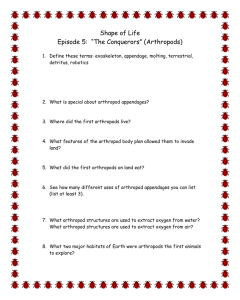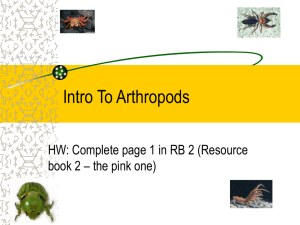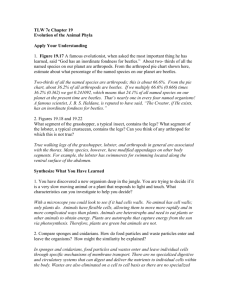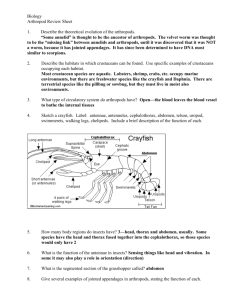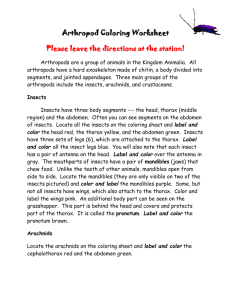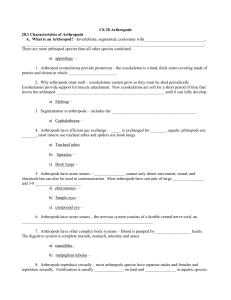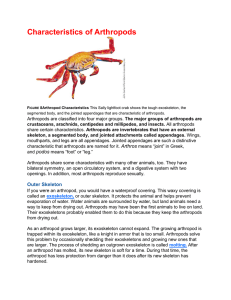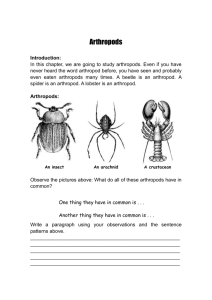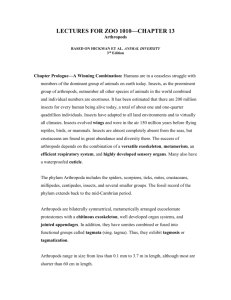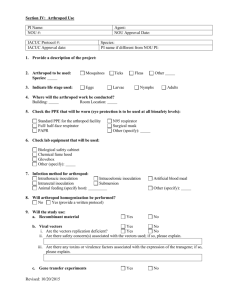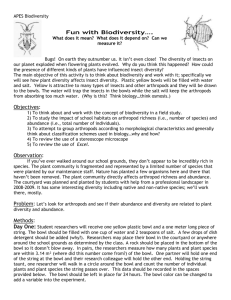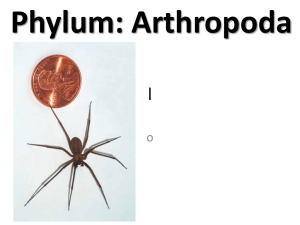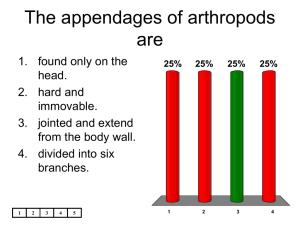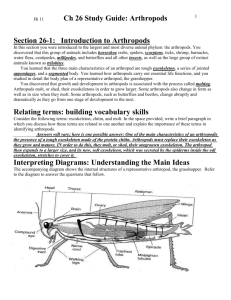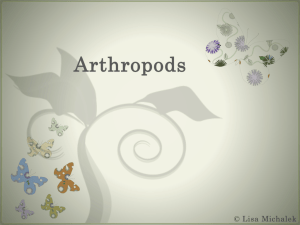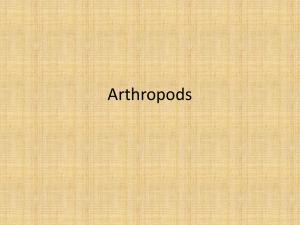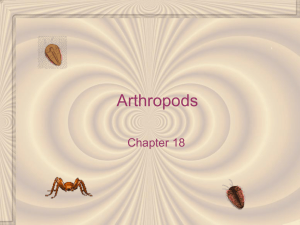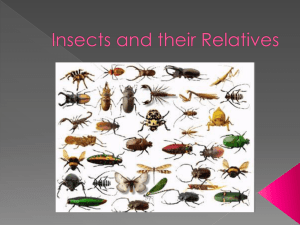Ch. 30 PowerPoint Notes
advertisement
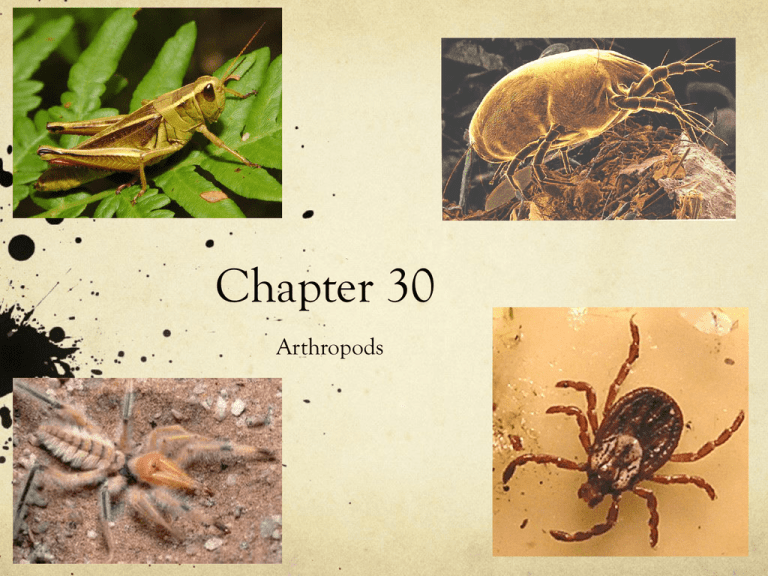
Chapter 30 Arthropods Section 1 Features of Arthropods Jointed Appendages Phylum Arthropoda = joint foot Appendage Structure that extends from the arthropod’s body wall Arthropod joints are able to bend Legs, antennae and mouth parts Like annelids, arthropods have a segmented body Well-preserved fossil specimens Arthropod Diversity Total # of arthropod species is more than all other animal species combined. Thought to be more than 5,000,000 species Range in size from 1mm – 12 ft. Arthropods divided into 2 groups: Jaws Fangs or pinchers Arthropod Body Plan All arthropods share numerous internal and external features Not all arthropods share all of the same features below: Jointed appendages Segmentation Distinct head w/ compound eyes Exoskeleton Respiration by gills, tracheae, or book lungs Open circulatory system Excretion through Malpighian tubules Wings Segmentation Often exists during the larval stage Butterfly Segments usually fuse to form 3 body regions: Head Thorax Mid-body region Abdomen The head may fuse with the thorax to form the cephalothroax Compound Eye Composed of multiple visual units Each unit contains: Lens and retina Allow them to sense motion very quickly Some arthropods also contain a single-lens eye that can only distinguish light from dark Horizon detectors Exoskeleton External skeleton (shell) composed of chitin Thin and flexible where joints are located Chitin is a tough material, but can be brittle As arthropods grow their exoskeletons become thicker to withstand the pull of larger muscles Molting Periodic shedding of the exoskeleton Also called ecdysis Allows arthropod to grow and develop Triggered by hormone release New exoskeleton hardens with a few hours to a few days Respiration Terrestrial arthropods Utilize tracheae Network of fine tubes Air enters body through spiracles which passes it on to tracheae Valves of spiracles allow air in and help prevent water loss Key adaptation to live on land Excretion Arthropod excretion conserves water and eliminates metabolic waste Malpighian tubules Finger-like extensions from the arthropod’s gut that are bathed in blood Process of excretion: Water and other particles move through the tubules and into the gut These particles are reabsorbed into body tissues Waste remains in the gut until expelled from the body Section 2 Spiders and Other Arachnids Arachnid Modifications Spiders, Scorpions, Ticks, Mites, Daddy longlegs Generally do more good than harm Chelicerae Mouthparts modified into pinchers or fangs 1st pair of appendages Pedipals Modified to catch and handle prey 2nd pair of appendages All except mites are carnivores Only able to consume liquid food Chelicerae modified into fangs Poison glands secrete toxins through fangs Toxins kill or paralyze fangs Enzymes are then injected to digest tissues into liquids 2 dangerous Species in the U.S.: Black widow Brown recluse Spinnerets Sticky strands of silk Spiders Scorpions and Mites Chelicerae and pedipalps are modified differently Scorpions Long, slender, segmented abdomens Abdomen ends in a venomous stinger Used to stun prey Pedipalps Large, grasping pinchers Used for capturing food Used during reproduction Mites Largest group of arachnids Includes chiggers and ticks Head, thorax and abdomen are fused Unsegmented bodies Aquatic mites herbivores Terrestrial mites carnivores Mites can affect plants and animals Mites can pass viral and fungal infections to plants Lyme disease is spread by infected deer ticks Section 3 Insects and Their Relatives Insect Diversity Terrestrial arthropods have chewing mouthparts (Mandibles) Insects, millipedes, and centipedes Insects are the largest group on earth 700,000 named species Many to still be discovered in the tropics 50% of all animal species are insects Insect Body Plan Head Mandibles (specialized mouthparts) 1 pair of antennae Large compound eyes Thorax 3 fused segments 3 pairs of jointed walking legs 1 or 2 pairs of wings Abdomen 9-11 segments No legs No wings Insect Life Cycle Metamorphosis The last molt a young insect undergoes Dramatic changes Complete metamorphosis Eliminates competition between adults and young Chrysalis Protective capsule that encloses the wingless, wormlike larva of a young insect Pupa Stage passed through while inside the chrysalis as it changes to adult form Incomplete metamorphosis Egg hatches into juvenile Nymph Small wingless adult Develops through several molts Flight Insects were first animals to have wings Allowed for greater evolution Wings composed of chitin Protrude from thorax Strengthened by veins Fold over abdomen Some insects are wingless Fleas and lice Usually only 1 pair of wings are used for flight Social Insects Hymenoptera (ants, bees and wasps) and Isoptera (termites) have elaborate social systems Many genetically related animals living together Caste Role played by a particular member Insect Relatives Centipedes and millipedes have similar bodies to insects Head region followed by segments Differ in number of legs Centipedes Carnivores Millipedes Herbivores Section 4 Crustaceans Crustacean Habitats Found throughout the world’s waters (oceans) “Insects of the sea” Fresh or saltwater Naupilus Larval stage of many crustaceans 3 pairs of branched appendages Undergoes a series of molts before becoming adult Mandibles Differences p. 680 – Table 2 Terrestrial Crustaceans Pill bugs and sow bugs Only true terrestrial crustaceans Found in leafy ground litter Gardens and wooded areas Land crabs slightly terrestrial Life cycle tied to the ocean Aquatic Crustaceans Key food source in many food chains Humans and animals Krill One of the main food sources for many marine species Decapods Shrimps, lobsters, crabs, crayfish Five pairs of legs Head and thorax are fused cephalothorax Protected by carapace Chelipeds pinchers Appendages called swimmerets Uropods Paddle-like appendage at end of abdomen Sessile Crustaceans Barnacles Sessile as adults Hard plate protects adults Feathery legs stir food into the mouth Hermaphrodites Do not fertilize their own eggs

